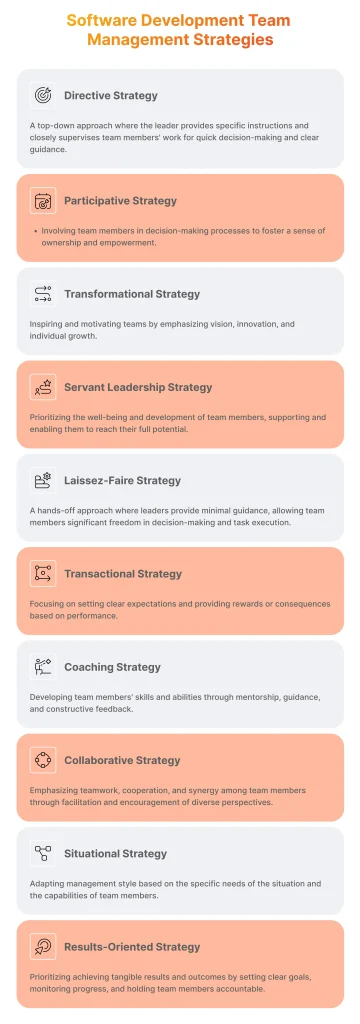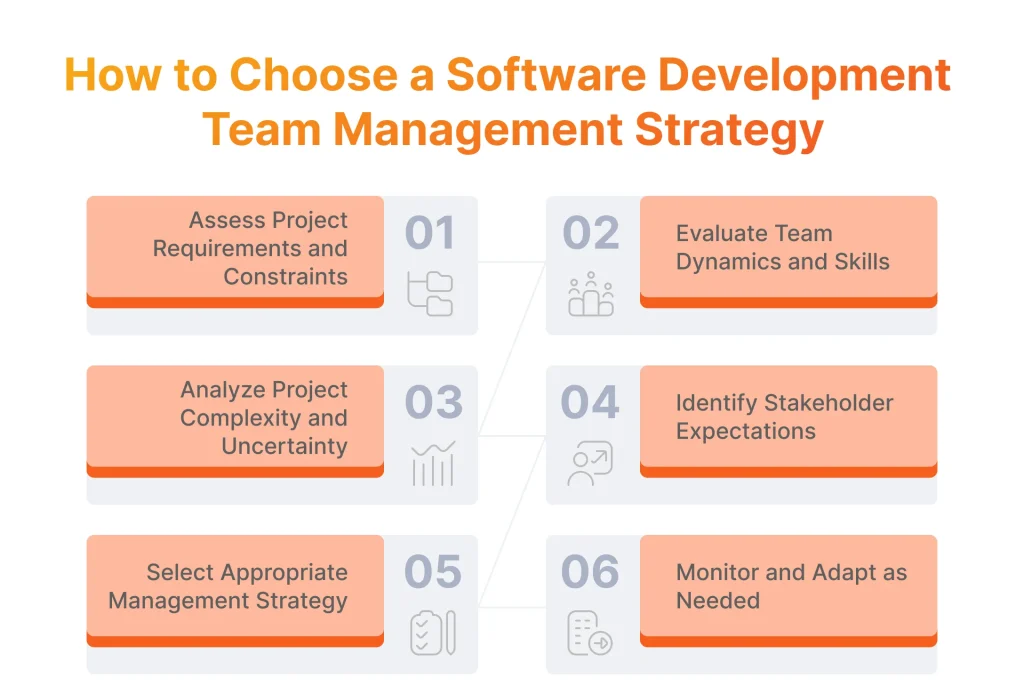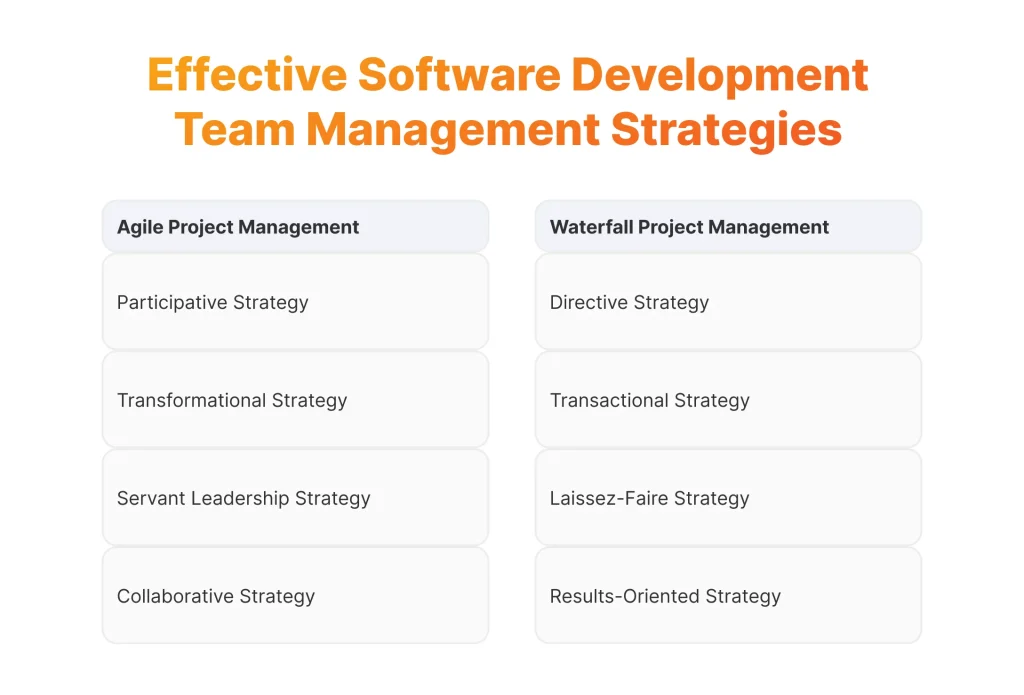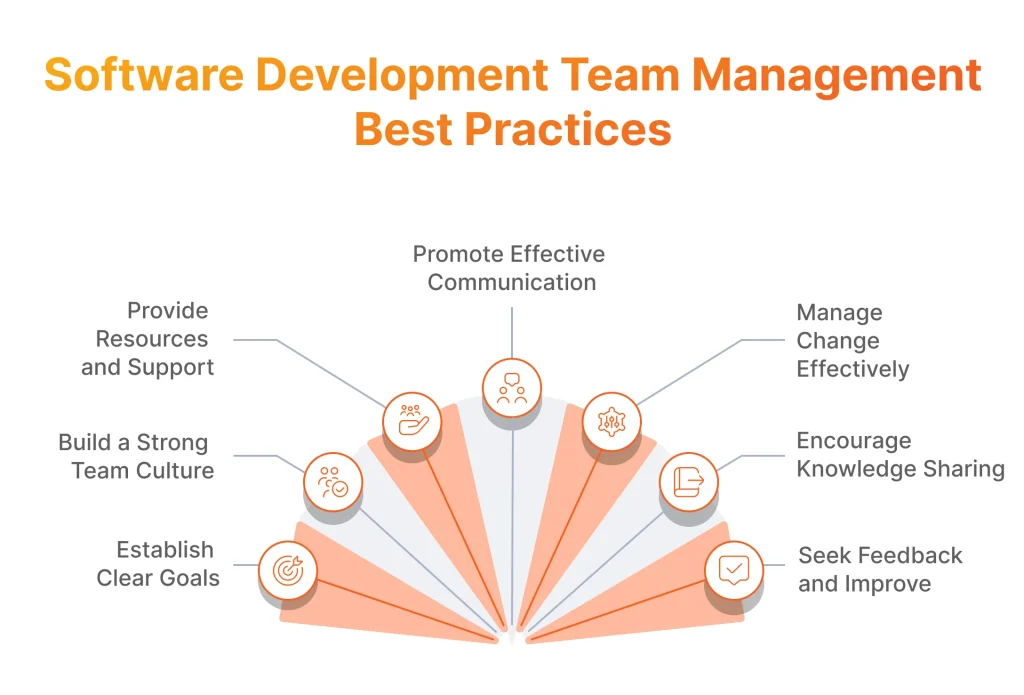As the IT industry continues to grow exponentially, according to Statista, the global revenue in the software development market is projected to reach USD 698.80 billion by the end of 2024. While the success of an outsourced product development always depends on multiple important factors, those companies that leverage effective strategies in managing software development teams have higher chances to succeed.
While you need to have an exceptional technical team on board, the success of your projects not only relies on the brilliance of individual developers, but also on the ability of team leaders to manage diverse talent, foster collaboration among team members, and navigate complex project dynamics.
In our previous articles, we already discussed the hiring aspects of offshore software development, so this time we will focus on management intricacies and help you maximize the efficiency of each team member for both in-house and remote teams.
10 Software Development Team Management Strategies with Examples
To get started, let’s discuss the most common strategies that will help you manage the software development process most efficiently. We will provide hypothetical project examples and will help you understand how to adjust your software development management style accordingly.

Directive Strategy
It is a project management approach characterized by a top-down, authoritarian leadership style where the project manager provides specific instructions and closely monitors the work of each team member. This approach is particularly suitable for situations where quick decision-making, clear guidance, and strict adherence to protocols are essential for project success.
Implementation Example
A directive strategy is a great option for a scenario like developing a critical software patch to address a security vulnerability. Security vulnerabilities pose significant risks to systems, data, and users, requiring immediate and decisive action to mitigate potential threats. Any hesitations here can harm not only the particular subproject but an entire organization and its customers.
Key actions of the project manager for this use case include:
- Providing clear and detailed instructions to the team regarding the scope of work, the specific security vulnerabilities that need to be addressed, and the protocols and procedures to follow.
- Knowing how to manage developers closely to ensure that they are following the prescribed security protocols, coding standards, and best practices, including regular check-ins, code reviews, and monitoring progress against established timelines.
- Given the critical nature of the project, the project manager must actively identify and mitigate potential risks that could compromise the security patch’s effectiveness or delay its delivery.
Participative Strategy
This one is commonly referred to as participative or democratic leadership strategy. Here, the project manager actively involves team members in decision-making processes, encouraging their input and fostering a sense of ownership and empowerment among the team. This style of software development management is particularly effective in projects that require creativity, innovation, and collaboration.

Olexandr Boyko
Delivery Director at SPD Technology
“Here at SPD Technology, we use participative strategy quite often. We believe that everyone’s input should be considered and valued to boost the morale of each individual. For this goal, we leverage SCRUM activities like daily standups, grooming, and planning sessions, in which ideally all developers are present, for setting up a workflow and communication process that allows promoting everyone’s contribution.
In addition to that, our client demos are shown by different people. We allow different experts to show the results to clients, and it is not just about encouraging participation and improving engagement and motivation, it is also about wider communication with each expert being able to comment on features and propose ideas.”
Implementation Example
This strategy is a great fit for such creative activity as designing a new User Interface for an application, which is an essential element of outsourcing web and mobile app development. Within the framework of such a creative task, each team member should be welcome to share their vision and ideas.
Key actions of the project manager for this use case include:
- Conducting brainstorming sessions where team members are encouraged to freely share their ideas, insights, and creative concepts.
- Organizing design workshops where team members collaborate on creating UI mockups, wireframes, and prototypes. During these workshops, team members work together to refine ideas, iterate on designs, and incorporate feedback from stakeholders.
- Leveraging collaboration tools like digital whiteboards, design collaboration platforms, and project management software to facilitate remote teamwork and improve communication.
Transformational Strategy
This one is also known as transformational leadership. The project manager, here, should inspire and motivate the teams by emphasizing a compelling vision, fostering innovation, and promoting individual growth. This leadership style is particularly effective in projects that require creativity, vision, and the pursuit of breakthrough solutions.
Implementation Example
Transformational strategy is vital in a startup environment when building a next-generation product that aims to revolutionize an industry is required. According to Exploding Topics, only one in ten startups survives, so proper implementation of this strategy is critical.
Key actions of the project manager for this use case include:
- Articulating a bold and inspiring vision for the product, painting a vivid picture of its potential impact on the industry and the value it will bring to customers.
- Creating an environment where experimentation and risk-taking are encouraged, empowering team members to push the boundaries of what’s possible.
- Cultivating a shared sense of purpose and belonging within the team, communicating the importance of each team member’s contribution to the project’s success, and fostering a strong sense of collaboration.
- Investing in the professional growth of each team member, providing opportunities for skill development, mentorship, and career advancement.

Olexandr Boyko
Delivery Director at SPD Technology
“Task delegation is also a powerful project management tool for empowerment and the promotion of individual growth. In our company, experts can try different roles. For example, a proactive back-end developer, when there is a necessity and agreed decision with a Tech Lead to do so, can take responsibility for creating an architecture for a certain feature of a product.
At SPD Technology, we have a Talent Management Department. Combined with the efforts of the People Manager, they create individual PDP (Personal Development Plan) for each expert working in a team. PDP allows an expert to constantly grow and extend their competencies while working within the confines of a product. An expert can try a new framework, switch to automated testing, try a Test-Driven Development (TDD) approach, or anything else that could unlock individual growth and match the goals of a product.”
Servant Leadership Strategy
Servant leaders prioritize the well-being, growth, and development of their team members above all else, creating a supportive and empowering environment where team members feel valued, motivated, and inspired to achieve their goals. Rather than asserting authority or control, they focus on supporting and enabling others to reach their full potential. This approach is particularly effective in projects that require collaboration, empowerment, and a high level of trust.
Implementation Example
Let’s take a major update to an existing software platform, as an example of implementation of this strategy.
Key actions of the project manager for this use case include:
- Addressing any challenges or roadblocks that arise, and ensuring that team members have the support they need to execute their tasks effectively.
- Offering guidance, mentorship, necessary project management software, and resources, as well as being available to listen to concerns and provide assistance whenever needed.
- Encouraging initiative and creativity, allowing team members to take ownership of their work and contribute their unique skills and perspectives to the project.
Laissez-Faire Strategy
With this one, leaders take a hands-off approach, providing minimal guidance and allowing team members significant freedom in decision-making and task execution. This management style is effective when team members are highly skilled in their respective areas, self-motivated, and capable of working independently.
Implementation Example
A great fit for this approach is a particular subproject that requires narrow expertise, like developing a custom web application for an internal tool. Software developers should have a deep understanding and technical skills and should be able to complete this task without much intervention from the manager.
Key actions of the project manager for this use case include:
- Providing minimal guidance and direction to the team, allowing them to take the lead in defining project goals, timelines, and deliverables. Instead of micromanaging, the project manager serves as a resource and sounding board for team members, taking away administrative tasks hassle.
- The project manager still monitors progress and provides support as needed to ensure that the project stays on track. Regular check-ins and updates may be scheduled to keep the project manager informed of progress and any potential issues that arise.
Need more details on the software development process?
Read our article for expert insight!
Transactional Strategy
In this approach, leaders focus on setting clear expectations, establishing structured systems for task completion and accountability, and providing rewards or consequences based on performance. Transactional leaders use a “give and take” approach, offering rewards or incentives for achieving specific goals and enforcing consequences for failing to meet expectations.
Implementation Example
It is a great strategy for integrating third-party APIs into an eCommerce platform. By the way, this strategy has proven to be beneficial for us working in eCommerce, as we successfully developed and deployed the Merchant Portal for one of our clients, a Global Gift Cards Distribution Company.
Key actions of the project manager for this use case include:
- Setting clear performance metrics, objectives, and milestones for the team, and defining technical requirements, deadlines, and quality standards for the project.
- Creating detailed project plans, defining roles and responsibilities, and implementing workflows to ensure efficient execution of tasks.
- Offering rewards or incentives to team members for meeting key objectives and milestones. For example, team members may be rewarded for successfully integrating a specific API within the allotted time frame or for achieving improvements in system performance as a result of the integration.
Coaching Strategy
Within the framework of this strategy, leaders focus on developing their team members’ skills and abilities through mentorship, guidance, and constructive feedback. They actively support individual growth and professional development, aiming to empower team members to reach their full potential.
Implementation Example
This management style is particularly effective in projects that involve learning new technologies or methodologies and overcoming unfamiliar web application development challenges, so let’s take, as an example, migrating legacy systems to a cloud-based infrastructure.
Key actions of the project manager for this use case include:
- Assessing the skills and knowledge gaps within the team. This may involve conducting skills assessments, discussing career aspirations with team members, and identifying areas for improvement.
- Conduct regular mentorship sessions and one-on-one meetings, sharing best practices, offering advice, and providing feedback to help team members develop their skills and overcome current challenges.
- Facilitating technical training sessions or workshops to help team members gain the knowledge and expertise needed.
Collaborative Strategy
In this style, the emphasis is on fostering teamwork, cooperation, and synergy among team members. Leaders actively facilitate collaboration, encourage knowledge-sharing, create an environment where diverse perspectives are valued and leveraged to achieve project goals.
Implementation Example
This approach is particularly effective in complex projects that require cross-functional teamwork and integration of various components, such as developing a multiplayer online game with complex gameplay mechanics.
Key actions of the project manager for this use case include:
- Organizing cross-functional, hybrid teams, each responsible for different aspects of the development process.
- Fostering collaboration among team members by creating opportunities for interaction and knowledge sharing.
- Valuing diverse perspectives and encouraging team members to bring their unique insights and ideas to the table.

Olexandr Boyko
Delivery Director at SPD Technology
“We have multiple projects, where the Project Manager delegates some of the tasks to be more effective. For example, when PM combines the roles of Project Manager, Tech Lead, and People Manager, it is reasonable to delegate scope management of the particular sprint to some expert, or even delegate the meeting facilitation for the scope grooming. A back-end developer with a positive attitude can easily take over such tasks, and in real-life scenarios, it happens very often.”
Situational Strategy
This is a management approach where leaders adapt their style based on the specific needs of the situation and the capabilities of their team members. This flexible approach allows leaders to assess each unique situation and adjust their leadership style accordingly to achieve the best outcomes.
Implementation Example
It can be very helpful in startup environments with the ever-changing needs of the project. In particular, for creating a software prototype for a startup with evolving requirements.
Key actions of the project manager for this use case include:
- Adapting leadership style to suit the needs of the current situation. During periods of uncertainty or complexity, the project managers should provide more guidance, direction, and support to the team to ensure that everyone remains focused and aligned with the project’s goals.
- Empowering team members to take ownership of their work and make decisions autonomously when appropriate.
- Acting as a mentor and coach, providing encouragement, feedback, and assistance to help team members succeed.
Results-Oriented Strategy
Leaders employing this approach prioritize achieving tangible results and outcomes above all else. They focus on setting clear goals, monitoring progress, and holding team members accountable for delivering results.
Implementation Example
This approach is particularly effective in projects with strict deadlines, such as developing a mobile application for a client with time-sensitive requirements.
Key actions of the project manager for this use case include:
- Setting clear, measurable goals and milestones for the project, aligning them with the client’s requirements and deadlines. These goals may include key deliverables, functionality requirements, and specific deadlines for completion.
- Monitoring progress towards achieving the project goals and milestones using project management software, tracking the team’s performance, identifying any potential bottlenecks or obstacles, and taking proactive measures to keep the project on track.
- Adjusting resources as needed based on the project’s progress and requirements.
- Establishing clear expectations of each team member, providing regular feedback on performance, and addressing any issues or concerns that may impact the project’s success.
Want to find out how to hire a dedicated development team in 2024 for your mobile or web project?
We have the article with all the latest information on this topic!
How to Choose a Software Development Team Management Strategy
Every business scenario is unique, so it is important to choose the most suitable approach for managing software development teams. In this section, we will provide you with some essential recommendations to help you pick the right software development team management approach.

Assess Project Requirements and Constraints
It will be a good idea to start by gathering detailed information about the project’s scope, objectives, timeline, budget, and technical requirements. You need to achieve a precise understanding of what needs to be accomplished exactly and the resources available to achieve those goals. Also, consider any constraints or limitations that may occur, such as regulatory compliance requirements, and human and technological resource availability.
Evaluate Team Dynamics and Skills
Assess the composition of the development team, and take into consideration their skills, experience, and working styles. This involves understanding the strengths and weaknesses of individual team members and how they complement each other. It is important to consider factors such as team cohesion, communication patterns, and leadership dynamics within the team. Make sure to evaluate the team’s capacity to handle the project’s requirements and any potential gaps in skills or expertise that need to be addressed.
Analyze Project Complexity and Uncertainty
Conduct an evaluation of complexity and uncertainty regarding the project. This includes assessing technical challenges, dependencies, and potential risks that could impact project delivery. Consider the degree of flexibility and adaptability required to address evolving project requirements, unforeseen challenges, and changing market conditions. The project’s scope and scale are also things to keep in mind before making a decision.
Identify Stakeholder Expectations
Communicate with project stakeholders to understand their expectations, priorities, and desired level of involvement in decision-making, soliciting their input throughout the project lifecycle. Consider any specific preferences or requirements expressed by upper management, such as preferred communication channels, reporting formats, or project management systems. Make sure that there is an alignment between stakeholder expectations and project goals to minimize and manage conflicting tasks.
Select the Appropriate Management Strategy
Based on the collected information, determine which approach to managing software engineers aligns best with the project’s needs and context. Consider the strengths and weaknesses of each existing strategy, such as Agile, Waterfall, Scrum, Kanban, or hybrid approach to custom software development, concerning the project’s objectives, team dynamics, and organizational culture. Pick a software development team management strategy that maximizes efficiency, promotes collaboration, and mitigates risks while addressing the unique requirements and constraints of the project.

Monitor and Adapt as Needed
Hopefully, you’ve done everything correctly and made the right decision, however, you still need to monitor team performance, project progress, and stakeholder feedback throughout the entire project lifecycle. Be prepared to adapt the management strategy as necessary based on changing circumstances, emerging challenges, or lessons learned from the completed iterations.
Ever-Green Tips for Software Development Team Management
Whatever strategy you choose, the following tips will help you manage a software development team effectively and keep everything under control.

Establish Clear Goals and Expectations
Before thinking about the team structure and considering candidates, or looking for overlapping time zone hours to set up an offshore development center, you should define the business expectations of stakeholders and set initial goals:
- It’s crucial to establish clear objectives, scope, and deliverables from the very beginning, which involves defining what needs to be accomplished and the expected outcomes of the project.
- Setting realistic timelines and milestones is essential to track project progress and ensure that the project stays on schedule.
- Effective communication is always vital, particularly in conveying expectations regarding quality standards, coding conventions, and project priorities to the development team.

Olexandr Boyko
Delivery Director at SPD Technology
“Often, we determine the goals and expectations for the project during the pre-sale phase, before signing a deal. We involve our Project Managers, Delivery Managers, and, when needed, domain experts and developers. This is a must for any project, and the importance of accurate planning here can’t be overestimated. This process is not exclusive to new projects. Our project Poynt, for example, had multiple remote software development teams working on it. However, when a new development direction was set, we re-determined the goals and expectations all over again to offer the most effective involvement possible.”
Build a Strong Team Culture
Creating a positive and inclusive team culture is essential for fostering your team’s productivity in the distributed software development environment. Always strive to build trust, promote respect, and encourage collaboration among team members.
Open communication channels, regular feedback sessions, and opportunities for idea-sharing help to improve the team dynamic, while recognizing and celebrating individual and team achievements play a crucial role in boosting morale and motivation, reinforcing a sense of accomplishment within the team.

Olexandr Boyko
Delivery Director at SPD Technology
“Trust is a key element in all human interactions. Here, at SPD Technology, we are encouraging open communication, allowing people to voice their opinions on each element of the development process and suggesting improvements. Positive culture and trust come as a result of this. Additionally, we have the role of People Manager, who is responsible for maintaining positive attitudes, while working with each expert individually.”
Provide Adequate Resources and Support
It’s imperative to ensure that team members have access to the essential project management software tools, technologies, and resources required to carry out their roles effectively. You need to provide the necessary hardware, project management software, and infrastructure. Keep in mind that offering training, mentorship, and professional development opportunities is another critical element essential to support skill growth and career advancement within the team.
Be ready to address any barriers or challenges that may hinder team productivity or performance, whether they are related to technical issues, workflow bottlenecks, or even interpersonal conflicts.
Promote Effective Communication
During the software development process, you need to make sure that existing communication, both client-vendor and internal, is sufficient and effective. Creating clear communication channels and protocols involves establishing ways for sharing updates, progress reports, and challenges among team members. Regular team meetings, stand-ups, and status updates play a vital role in keeping everyone informed and aligned with project goals and timelines. Always foster a culture of transparency and collaboration, encourage active listening, and seek input from team members during discussions.
Successfully Manage Change
Embracing Agile principles, along with the most popular Scrum methodology (with an 87% usage rate, according to the 17th State of Agile Report), is essential for navigating the modern landscape of software development. This involves prioritizing flexibility and responsiveness in project planning and execution to accommodate changing requirements and priorities effectively. Agile methodologies emphasize iterative development, which allows development teams to adapt to evolving needs and deliver incremental value to stakeholders. To get the most commitment out of your team, make sure to communicate any changes transparently and involve your experts to some extent in the decision-making process.
Encourage Collaboration and Knowledge Sharing
Establishing cross-functional collaboration and knowledge sharing among team members will only improve the outcomes of your project, especially for outsourcing models like IT Staff Augmentation. It will be a good idea to promote such practices as code reviews, pair programming, and collaborative problem-solving to improve code quality and team cohesion. It will also be nice to have a knowledge base with documentation standards and repositories for sharing best practices, lessons learned, and project insights to improve the onboarding speed for the new team members.
Seek Feedback and Continuously Improve
You should be prepared for a constant dialogue between the stakeholders and the team from the software product development company, seeking ways to find more creative approaches to team configuration, internal processes, and communication.The project manager should be responsible for this area, preventing, discovering, reacting and taking action to eliminate blockers. An efficient PM can uncover ways for improvement during daily team meetings, retrospectives, and one-to-one meetings to assign developers specific tasks using project management platforms that will solve possible bottlenecks.

Olexandr Boyko
Delivery Director at SPD Technology
“As a recent example of process improvement, we had an overload in a remote software development team working on one of our major projects. The experts were working with an extremely high load for a few months. Investigation showed that the management on the client’s side had put unprecedented pressure on our team and the manager on our side accepted the high volume of tasks, despite it being too much for the developers to work on comfortably. We fixed this situation and adjusted expectations on both our and the client’s sides, and as a result, we significantly improved the overall quality of work, climate inside our team, and development process.”
Conclusion
An effective software development team management is a tall task that requires a combination of effective leadership, clear communication, adaptability to change, and strategic planning to pull off properly. We hope that by leveraging the strategies and tips we shared, you can help your leading software teams deliver high-quality solutions that meet stakeholders’ expectations and drive organizational success in an evolving world of technology. If you need any help with it, get in touch with us for more pieces of advice!
FAQ
- How to effectively manage a remote software team?
It’s a complex activity that involves a wide range of elements, from technical skills, and knowledge of methodologies, to having experience to make the right decisions on the spot. If you don’t have any tech experience, managing software development may seem like a big challenge. However, if you want to manage a software team, you don’t need to know how the code works or how the architecture is built to achieve great results. You can start by learning the common challenges of the IT industry, find out how to use project management tools, and get familiar with the best practices.
- What are software development team management strategies?
The most important software development management strategies you should be aware of include:
- Directive Strategy
- Participative Strategy
- Transformational Strategy
- Servant Leadership Strategy
- Laissez-Faire Strategy
- Transactional Strategy
- Coaching Strategy
- Collaborative Strategy
- Situational Strategy
- Results-Oriented Strategy.


